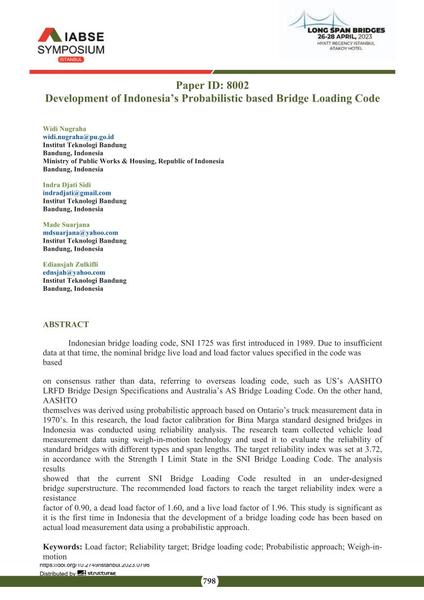Development of Indonesia’s Probabilistic based Bridge Loading Code

|
|
|||||||||||
Détails bibliographiques
| Auteur(s): |
Widi Nugraha
(Institut Teknologi Bandung Bandung, Indonesia; Ministry of Public Works & Housing, Republic of Indonesia Bandung, Indonesia)
Indra Djati Sidi (Institut Teknologi Bandung Bandung, Indonesia) Made Suarjana (Institut Teknologi Bandung Bandung, Indonesia) Ediansjah Zulkifli (Institut Teknologi Bandung Bandung, Indonesia) |
||||
|---|---|---|---|---|---|
| Médium: | papier de conférence | ||||
| Langue(s): | anglais | ||||
| Conférence: | IABSE Symposium: Long Span Bridges, Istanbul, Turkey, 26-28 April 2023 | ||||
| Publié dans: | IABSE Symposium Istanbul 2023 | ||||
|
|||||
| Page(s): | 798-810 | ||||
| Nombre total de pages (du PDF): | 13 | ||||
| Année: | 2023 | ||||
| DOI: | 10.2749/istanbul.2023.0798 | ||||
| Abstrait: |
Indonesian bridge loading code, SNI 1725 was first introduced in 1989. Due to insufficient data at that time, the nominal bridge live load and load factor values specified in the code was based on consensus rather than data, referring to overseas loading code, such as US’s AASHTO LRFD Bridge Design Specifications and Australia’s AS Bridge Loading Code. On the other hand, AASHTO themselves was derived using probabilistic approach based on Ontario’s truck measurement data in 1970’s. In this research, the load factor calibration for Bina Marga standard designed bridges in Indonesia was conducted using reliability analysis. The research team collected vehicle load measurement data using weigh-in-motion technology and used it to evaluate the reliability of standard bridges with different types and span lengths. The target reliability index was set at 3.72, in accordance with the Strength I Limit State in the SNI Bridge Loading Code. The analysis results showed that the current SNI Bridge Loading Code resulted in an under-designed bridge superstructure. The recommended load factors to reach the target reliability index were a resistance factor of 0.90, a dead load factor of 1.60, and a live load factor of 1.96. This study is significant as it is the first time in Indonesia that the development of a bridge loading code has been based on actual load measurement data using a probabilistic approach. |
||||
